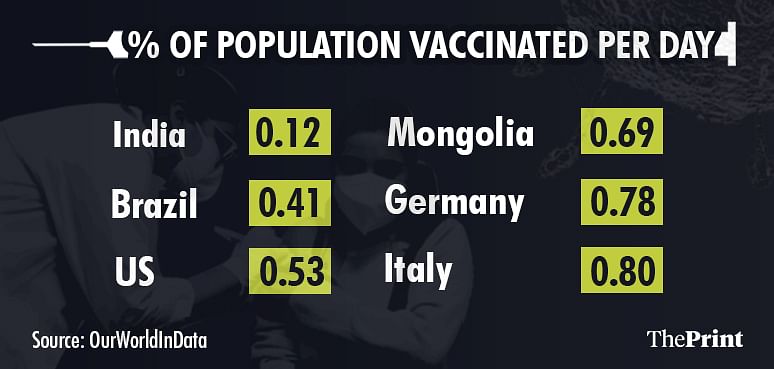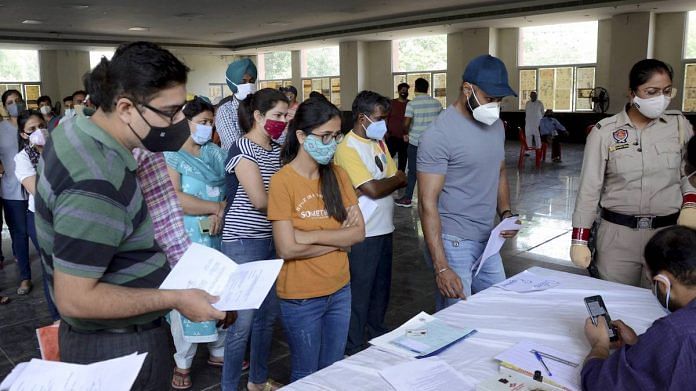New Delhi: India’s average daily vaccinations hit a high in April, but slumped to almost half of that in May after vaccinations opened up for all adults at the start of the month.
In April, India, on an average, administered 30,24,362 vaccine doses per day. In May, that number has come down to an average of 16,22,087 vaccine doses per day. This as the Centre and state trade blame and citizens continue to struggle to find slots on the CoWin platform, the government’s centralised system for booking a vaccine dose, while the pandemic remains in its most virulent phase yet.
These numbers are in line with the fact that India’s vaccine supplies nearly halved in May. Last month, when vaccinations were opened up to people aged 45 and above in the second Covid-19 immunisation phase, India administered a little less than 9 crore vaccine doses. However, in May so far, the total vaccine doses allocated — both from the central government’s kitty and those procured by states — stand at a little over 4 crore doses.
As of 18 May, India administered 18,58,09,302 vaccine doses since the national Covid vaccination programme was launched on 16 January. The daily average vaccinations in this 123-day period stands at 15,10,644. That means India has on average been vaccinating 0.12 per cent of the population per day, making it the lowest vaccination rate in the world.
The US is vaccinating about an average 0.5 per cent of its population daily, the UK is 0.76 per cent, Germany 0.78 per cent, Italy 0.8 per cent and Canada is vaccinating 0.96 per cent of its population per day.

What will likely add to India’s low vaccination rate is the fact that the government has now doubled the dose gap between the two doses required to fully vaccinate people taking Covishield, the AstraZeneca-Oxford University shot being produced by Serum Institute of India. This decision has added to the speculation that vaccine shortages have forced the government’s hand.
The government has officially denied there being any shortage, but multiple studies across the world have suggested delaying the second dose as one of the options that can be explored in a vaccine scarce situation.
“The delayed second dose strategy was optimal for vaccine efficacies at or above 80% and vaccination rates at or below 0.3% of the population per day, under both sterilizing and non-sterilizing vaccine assumptions, resulting in absolute cumulative mortality reductions between 26 and 47 per 100 000. The delayed second dose strategy for people under 65 performed consistently well under all vaccination rates tested,” reads a BMJ article from April 2021.
Also read: India’s vaccine shortage threatens to prolong its Covid crisis
Trust scientists, government says
In a briefing last week, NITI Aayog member (health) Dr V.K. Paul had rejected the notion that the decision to delay the second dose of Covishield was linked to a shortage of vaccines.
“…A second thing was said when we said the Covishield dose gap has been increased to 12-16 weeks — it is being trivialised that these decisions have been taken under pressure, a narrative is being built of shortage … this is very sad … NTAGI is a standing committee that has been there for long. It is independent and we must respect these institutions,” Dr Paul had said.
The NTAGI is the National Technical Advisory Group on Immunisation in India that advises the government on new vaccines and its immunisation policy.
Dr Paul had claimed that the dose gap has been increased because the percentage of breakthrough infections (i.e., infections among fully vaccinated populations) are less when the second dose is delayed. Incidentally, on the day India announced its decision, the UK decided to shorten the window between both doses to after eight weeks instead of 12. The decision was taken citing concerns about a variant of the SARS-CoV-2 virus believed to have originated in India.
Also read: 3 UK studies ‘helped’ India decide on wider Covishield dose gap, but none cites 16-week data
Studies that looked at vaccine scarce situations
In February this year, The Lancet published a pooled analysis of four trials to assess the effects of single-dose administration and the influence of the timing of the booster dose on immunogenicity and efficacy of ChAdOx1 nCoV-19 (AZD1222), which is the Covishield vaccine. Researchers specified that this is one of the options that can be explored to rapidly vaccinate more people when vaccine doses are scarce. However, even this study did not prescribe delaying it beyond 12 weeks.
In fact, most studies on single dose efficacy stop at the 12-week interval and not 16 weeks, the threshold India is currently recommending. In a March 2021 study, The Lancet reported: “Modelling analyses showed an increase in vaccine efficacy after two standard doses from 55.1% with an interval of less than 6 weeks to 81.3% with an interval of at least 12 weeks.”
This means the efficacy of the second dose improved to 81.3 per cent after an interval of at least 12 weeks between both doses from 55.1 per cent after an interval of less than six weeks.
“A single standard dose had an efficacy against symptomatic COVID-19 in the first 90 days of 76.0%, yet provided no protection against asymptomatic infection,” the study further noted.
(Edited by Manasa Mohan)
Also read: How long can you wait to take 2nd Covishield dose? What experts say & the science behind it



